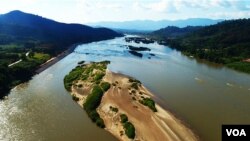ບັນດານັກວິຈານ ກ່ຽວກັບ ເຂື່ອນໄຟຟ້າ ໄຊຍະບູລີ ທີ່ມີກຳລັງ 1,285 ເມກະວັດ ໃນ
ພາກເໜືອຂອງລາວ ຢ້ານວ່າ ການປັບປຸງເມື່ອບໍ່ດົນມານີ້ຕໍ່ໂຄງການທີ່ມີບັນຫາດັ່ງກ່າວ
ຈະບໍ່ພຽງພໍທີ່ຈະຮັກສາແມ່ນ້ຳຂອງຈາກສະຖານະການທີ່ຮ້າຍແຮງ ເມື່ອເຂົາເຈົ້າເລີ່ມ
ຜະລິດໄຟຟ້າຢ່າງເຕັມທີ່ໃນເດືອນໜ້າ.
ຫຼັງຈາກການກໍ່ສ້າງດົນ 7 ປີ, ມັນຈະເປັນເຂື່ອນທຳອິດຈາກ 11 ແຫ່ງທີ່ຖືກວາງແຜນ
ໄວ້ສຳລັບແມ່ນໍ້າທາງພາກໃຕ້ຂອງ ຈີນ, ເຊິ່ງໄດ້ສ້າງເຂື່ອນ 11 ແຫ່ງຢູ່ຕາມແມ່ນ້ຳຂອງ
ນັ້ນແລ້ວ, ທີ່ຈະເລີ່ມປະຕິບັດງານ.
ປະຊາຊົນ 50 ລ້ານຄົນທີ່ອາໄສຢູ່ຕາມລຳແມ່ນ້ຳຂອງ ແມ່ນອາໄສການທຳມາຫາກິນຢູ່
ແມ່ນ້ຳດັ່ງກ່າວ, ດ້ວຍປາ ແລະ ຕະກອນ ທີ່ມັນພັດມານຳ. ບັນດານັກຄົ້ນຄວ້າ ແລະ ຜູ້
ສະໜັບສະໜູນສິ່ງແວດລ້ອມກ່າວວ່າ ເຂື່ອນດັ່ງກ່າວອາດໄປກີດກັ້ນທັງສອງຢ່າງນັ້ນ.
ທ່ານ ບຣາຍອັນ ອາຍເລີ ນັກວິໄຈອາວຸໂສ ຢູ່ສູນກາງ ສຕິມສັນ ທີ່ມີຫ້ອງການຕັ້ງຢູ່ນະ
ຄອນຫຼວງ ວໍຊິງຕັນ, ຜູ້ທີ່ນຳໜ້າກຸ່ມຄົ້ນຄວ້າໂຄງການນະໂຍບາຍແມ່ນ້ຳຂອງ ໄດ້ກ່າວ
ຕໍ່ວີໂອເອວ່າ “ດ້ວຍໄພແຫ້ງແລ້ງຂອງປີນີ້ ແລະ ການມີສ່ວນໃນລະດັບແມ່ນ້ຳທີ່ຕ່ຳກວ່າ
ເກົ່າຈາກ ຜົນກະທົບທີ່ສະສົມມາຈາກການກັກນ້ຳໄວ້ຢູ່ຕົ້ນຂອງເຂື່ອນ, ຂ້າພະເຈົ້າຄິດ
ວ່າ ສິ່ງທີ່ເອີ້ນວ່າ ຜົນກະທົບຕໍ່ລະບົບນິເວດຂອງແມ່ນ້ຳຂອງ ແມ່ນອາດໄດ້ມາຮອດແລ້ວ.
ຖ້າບໍ່ແມ່ນ, ມັນກໍຄົງຈະຫຍັບເຂົ້າມາໃກ້ໆໃນໄວໆນີ້.”
ທ່ານໄດ້ກ່າວວ່າ “ນັ້ນກໍໝາຍຄວາມວ່າ ຜົນກະທົບທີ່ສະສົມມາຂອງເຂື່ອນພວກນີ້ ແມ່ນ
ກຳລັງສ້າງຂະບວນການທີ່ຈະຫຼຸດຜ່ອນຄວາມໃຫຍ່ໂຕຂອງແມ່ນ້ຳຂອງ ໄປເປັນແມ່ນ້ຳ
ທີ່ຖືກຄວບຄຸມ ແລະ ຖືກຈັດການທັງໝົດໃນທີ່ສຸດ, ແລະ ດັ່ງນັ້ນ ຊັບສິນທຳມະຊາດຂອງ
ສິ່ງທີ່ແມ່ນ້ຳຂອງໄດ້ສະໜອງໃຫ້ນັ້ນແມ່ນຈະຖືກກະທົບ ແລະ ອາດຖືກລົບລ້າງໄປ.”
ແມ່ນ້ຳດັ່ງກ່າວໄຫຼຍາວກວ່າ 4,000 ກິໂລແມັດຈາກພູພຽງ ຕິເບດ ຂອງຈີນ ຜ່ານ ມຽນມາ,
ໄທ, ລາວ, ກຳປູເຈຍ ແລະ ຫວຽດນາມ ຫາທະເລຈີນໃຕ້.
Critics of the 1,285-megawatt Xayaburi hydropower dam in northern Laos fear recent upgrades to the controversial project won't be enough to save the Mekong River from a critical tipping point when it starts churning out electricity at full throttle next month.
After seven years of construction, it will be the first of 11 dams planned for the river south of China — which has built 11 dams across the Mekong already — to go online.
Some 50 million people downstream rely for a living on the river's waters, along with the fish and sediment it washes their way. Researchers and environmental advocates say the dam could block both.
"With this year's drought and the contribution to lower river levels from the cumulative effects of upstream dams holding back water, I think that the so-called ecological tipping point of the Mekong might have already arrived; if not, it's certainly fast approaching," Brian Eyler, a senior fellow at the Washington-based Stimson Center who heads the research group's Mekong Policy Project, told VOA.
"That means that the cumulative effects of these dams are creating processes that ultimately reduce the mightiness of the Mekong to a river that is harnessed and entirely managed, and therefore the natural properties of what the Mekong provides are stunted or potentially erased," he said.
The river runs more than 4,000 kilometers from China's Tibetan plateau through Myanmar,Thailand, Laos, Cambodia and Vietnam to the South China Sea.





